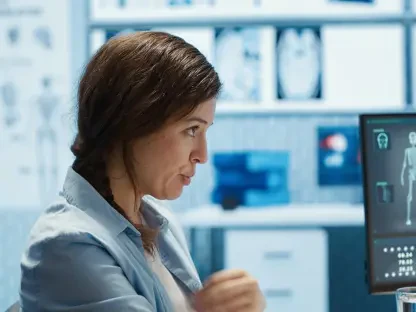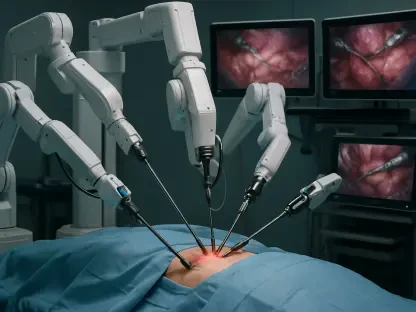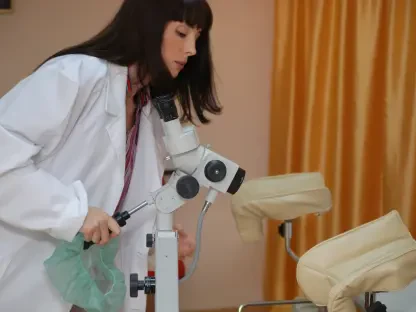In the intricate world of orthopedic surgery, few injuries present as much complexity and long-term concern as posterior malleolar fractures, a specific type of ankle injury affecting the back portion of the tibia at the joint. These fractures, which account for a significant percentage of ankle injuries, often challenge surgeons due to their direct influence on joint stability and the potential for debilitating complications like posttraumatic osteoarthritis. A pivotal element in managing these injuries lies in understanding the “step-off” level, which refers to the degree of misalignment or displacement at the fracture site after surgical intervention. Research consistently points to this factor as a determinant of both radiological changes and functional recovery, making it a focal point for improving patient outcomes. Delving into the nuances of step-off levels offers critical insights for medical professionals aiming to minimize joint damage and enhance quality of life for those affected. This exploration seeks to illuminate the profound relationship between step-off levels and the prognosis of posterior malleolar fractures, shedding light on why precision in surgical alignment can be transformative.
Unpacking the Nature of Posterior Malleolar Fractures
Posterior malleolar fractures represent a critical subset of ankle injuries, constituting between 7% and 44% of all such cases, often occurring alongside trimalleolar fractures that involve multiple parts of the ankle structure. Their significance stems from the posterior malleolus’s role in maintaining stability within the tibiotalar joint and the distal tibiofibular complex, essential components for proper ankle function. When fractured, any deviation in alignment can disrupt the congruity of the joint, placing undue stress on surrounding cartilage and heightening the risk of degenerative conditions over time. This type of injury frequently results from high-impact trauma, such as falls or accidents, and requires meticulous attention to prevent long-term impairment. The complexity of these fractures lies not only in their anatomical impact but also in the variability of treatment outcomes based on surgical precision. As a result, understanding the underlying mechanics and risks associated with posterior malleolar fractures becomes paramount for orthopedic specialists striving to restore normal joint function.
The concept of step-off, defined as the vertical displacement between fracture fragments post-reduction, emerges as a central concern in the treatment process. Measured in millimeters, step-off levels are typically categorized into three groups: less than 1 mm indicating near-perfect alignment, 1-2 mm suggesting acceptable but suboptimal reduction, and greater than 2 mm reflecting poor alignment. Even minor misalignments can lead to significant consequences, as they alter the load distribution across the ankle joint, potentially accelerating wear and tear on articular surfaces. This measurement serves as a critical benchmark for surgeons during operative planning and postoperative assessment. Advances in imaging technology have further refined the ability to evaluate step-off with precision, guiding interventions to achieve optimal outcomes. The focus on this metric underscores a broader shift in orthopedic care toward prioritizing anatomical accuracy to mitigate future complications.
Linking Step-Off Levels to Joint Degeneration
One of the most pressing complications associated with posterior malleolar fractures is the onset of posttraumatic osteoarthritis, a degenerative condition characterized by persistent pain, stiffness, and reduced joint mobility. Extensive studies highlight a stark correlation between step-off levels and the likelihood of developing this condition, with patients exhibiting misalignments greater than 1 mm facing a substantially elevated risk. The uneven joint surfaces resulting from such displacements create abnormal stress points, accelerating cartilage breakdown and fostering an environment conducive to osteoarthritis. This degenerative process not only impacts physical function but also imposes a significant emotional and economic burden on affected individuals through chronic discomfort and the potential need for further interventions. As such, the relationship between step-off and osteoarthritis stands as a critical consideration in shaping surgical strategies aimed at preserving joint health over the long term.
Further analysis reveals a threshold effect concerning step-off levels and joint degeneration, where any displacement beyond 1 mm markedly increases the incidence of osteoarthritis, yet the risk does not significantly escalate between the 1-2 mm and over 2 mm categories. This finding suggests that achieving near-anatomical reduction is paramount, as even slight misalignments can trigger irreversible damage to the joint structure. Patients with step-offs exceeding the minimal threshold often show higher rates of degenerative changes on imaging assessments, reinforcing the need for precision during surgical fixation. Such insights challenge surgeons to refine their techniques and leverage advanced tools to minimize displacement. The implications of this threshold effect extend beyond immediate recovery, emphasizing proactive measures to prevent a cascade of joint deterioration that could compromise mobility for years to come.
Functional Implications of Step-Off Misalignment
Beyond the radiological evidence of joint damage, step-off levels profoundly influence functional outcomes, determining how effectively patients can return to daily activities post-surgery. Evaluation tools such as the Olerud-Molander score, which assesses overall ankle performance, and the Visual Analog Scale, which measures pain intensity, provide quantifiable metrics for these outcomes. Patients with step-offs under 1 mm consistently report superior scores, indicating better ankle function, reduced pain, and minimal restrictions in movement. This group often regains near-normal capabilities, allowing for a smoother reintegration into routine tasks and physical activities. The data underscores the tangible benefits of achieving precise alignment, as it directly correlates with enhanced recovery experiences and improved patient satisfaction following treatment.
Conversely, individuals with step-offs ranging from 1-2 mm or exceeding 2 mm encounter noticeable declines in functional capacity, marked by persistent pain and limitations in ankle dorsiflexion. These functional deficits translate into challenges with walking, climbing stairs, or engaging in sports, significantly impacting quality of life. The lack of significant difference in outcomes between the 1-2 mm and greater than 2 mm groups further illustrates that any deviation beyond anatomical reduction carries substantial consequences. Such findings highlight the urgency of addressing even minor misalignments during surgery to prevent long-lasting impediments. For patients, this often means extended rehabilitation periods and potential adaptations to cope with reduced mobility. The broader implication for healthcare providers is a call to prioritize surgical precision to avert these functional setbacks and support optimal recovery trajectories.
Identifying Step-Off as a Primary Risk Factor
Emerging research consistently positions step-off as a standalone risk factor for adverse outcomes in posterior malleolar fractures, distinguishing it from other variables such as the size of the fractured fragment or specific fracture patterns. Unlike fragment size, which some studies have debated as a predictor of prognosis, step-off demonstrates a direct and consistent association with both the development of osteoarthritis and declines in functional performance. This distinction elevates step-off to a critical focus in clinical decision-making, urging orthopedic teams to concentrate efforts on minimizing displacement during surgical procedures. By identifying step-off as a primary concern, medical professionals can better tailor interventions to address the root causes of poor outcomes, enhancing the likelihood of successful recovery for their patients.
Moreover, the presence of posttraumatic osteoarthritis itself exacerbates functional decline, creating a compounding cycle of joint damage and impaired mobility that further complicates recovery. Patients with higher step-off levels not only face an increased likelihood of degenerative changes but also struggle with the downstream effects of these changes on daily function. This interconnected relationship between step-off, osteoarthritis, and functional impairment emphasizes the need for early and accurate intervention to break the cycle of deterioration. Surgeons are thus encouraged to adopt rigorous standards for reduction quality, recognizing that failure to achieve near-perfect alignment can initiate a cascade of negative effects. Addressing step-off as a key risk factor also informs postoperative care, highlighting the importance of monitoring and supporting patients to mitigate long-term consequences.
Emphasizing Surgical Precision for Optimal Alignment
Achieving a step-off of less than 1 mm, often referred to as anatomical reduction, stands as the gold standard in the surgical management of posterior malleolar fractures. This benchmark reflects the understanding that near-perfect alignment significantly reduces the risk of complications and supports better long-term joint health. Surgeons employ a variety of techniques and approaches, such as posterolateral or posteromedial access, tailored to the specific fracture pattern to optimize outcomes. The pursuit of this standard requires not only technical skill but also a commitment to leveraging cutting-edge tools to enhance accuracy. As the field of orthopedic surgery continues to evolve, the emphasis on anatomical reduction serves as a guiding principle for improving patient prognosis and minimizing the burden of secondary conditions.
Advanced imaging technologies, particularly computed tomography (CT) scans, play an instrumental role in achieving precise step-off measurements, offering a marked improvement over traditional X-ray methods. These tools provide detailed, three-dimensional views of the fracture site, enabling surgeons to plan and execute interventions with greater confidence. Intraoperative imaging further assists in real-time assessment, ensuring that any misalignments are corrected before concluding the procedure. The integration of such technologies into routine practice reflects a broader trend toward precision medicine in orthopedics, where individualized and data-driven approaches enhance treatment efficacy. By prioritizing anatomical reduction through these means, healthcare providers can substantially lower the incidence of adverse outcomes, paving the way for more consistent and favorable recovery experiences.
Navigating Controversies in Step-Off Significance
Despite widespread recognition of step-off’s importance, the orthopedic community continues to grapple with debates over its relative weight compared to other factors in managing posterior malleolar fractures. Some research advocates for aggressive treatment of larger fragments, positing that the extent of articular surface involvement may influence outcomes more than alignment quality. In contrast, a growing body of evidence aligns with the perspective that step-off remains the dominant predictor of prognosis, irrespective of fragment size. These differing viewpoints underscore the complexity of ankle fracture management, where multiple variables interact to shape patient results. Resolving such controversies requires ongoing dialogue and research to refine clinical guidelines and ensure that treatment protocols reflect the most current and comprehensive understanding of these injuries.
The variability in perspectives also points to the necessity of personalized approaches in treating posterior malleolar fractures, acknowledging that each patient’s injury presents unique challenges. Surgeons must weigh the specific characteristics of the fracture, alongside step-off measurements, to determine the most effective intervention strategy. This tailored methodology ensures that treatment plans address the individual nuances of each case, optimizing the potential for successful outcomes. As debates persist, the field benefits from a diversity of insights that drive innovation and critical evaluation of established practices. The focus on step-off as a central factor, while not universally agreed upon, continues to shape surgical priorities, encouraging a meticulous approach to reduction that can significantly alter the trajectory of patient recovery.
Reflecting on Past Challenges and Future Directions
Looking back, the management of posterior malleolar fractures grappled with significant hurdles, as earlier approaches often underestimated the role of precise alignment in preventing long-term complications. Historical reliance on less accurate imaging and varying surgical standards led to inconsistent outcomes, with many patients enduring persistent pain and mobility issues due to unaddressed step-off misalignments. The recognition of step-off as a critical determinant marked a turning point, prompting a shift toward more rigorous reduction techniques and better diagnostic tools. These past challenges served as a catalyst for advancements in orthopedic care, highlighting the importance of learning from previous limitations to improve future practices. The evolution in understanding underscored a collective commitment to enhancing patient care through refined methodologies.
Moving forward, the emphasis should be placed on integrating advanced imaging and surgical technologies into standard protocols to consistently achieve anatomical reduction in posterior malleolar fractures. Investment in prospective studies with extended follow-up periods will be crucial to fully grasp the progression of conditions like osteoarthritis and validate current findings over time. Additionally, fostering collaboration among orthopedic specialists to standardize treatment approaches can help bridge existing controversies and ensure uniform care quality. Educational initiatives for both surgeons and patients about the significance of step-off levels may further improve adherence to best practices and rehabilitation protocols. By building on past lessons, the field can continue to advance, offering hope for better outcomes and sustained joint health for those affected by these complex injuries.









